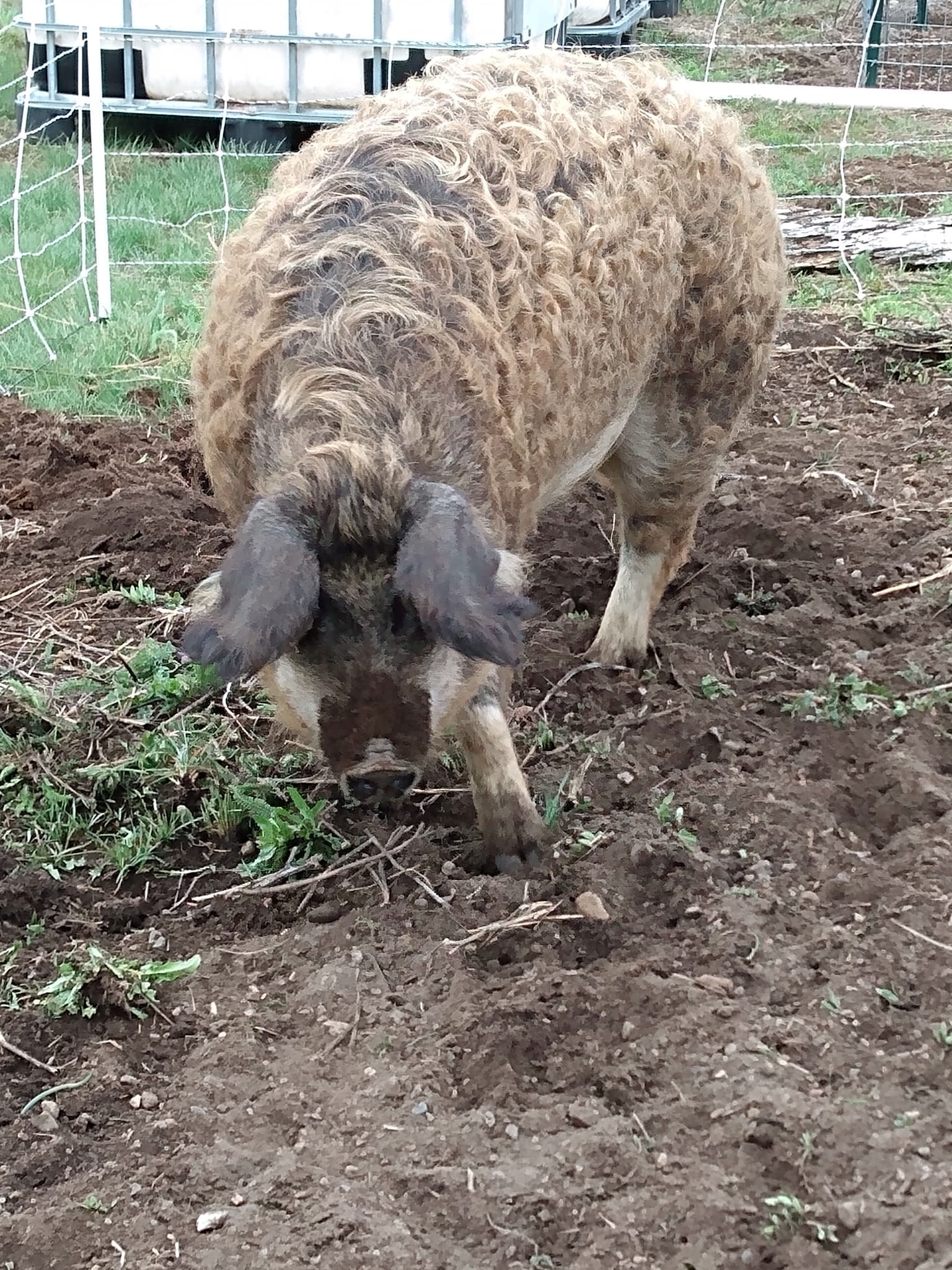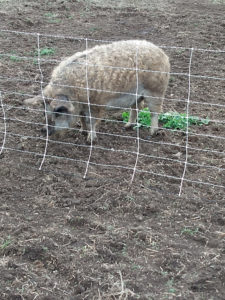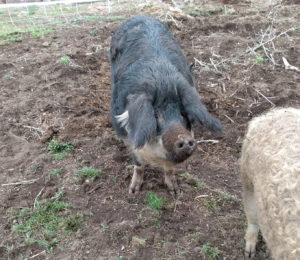We are pleased as punch to welcome heritage pigs to Highland Glenn Ranch – the noble Mangalitsa. It didn’t take long to fall in love with these charming pigs full of personality!
Mangalitsa (pronounced mahn-ga-leetz-ah) is a rare and rustic lard-type swine breed developed in several countries of the Austro-Hungarian Empire from 1833 onward. They are noted for their gourmet red meat that is perfect for charcuterie (dried cured meats), juicy even after cooking, and more tender than the commercially raised pork most people are accustomed to. Mangalitsa pork is not the “other white meat” by a long shot! They also produce a large amount of luscious fat with a uniquely healthful nutrient profile.
Referred to as the “wooly pig” due to its abundance of long curly hair, the heritage Mangalitsa (also spelled Mangalica or Mangalitza) cold hardiness, even temperament, and ability to produce outstanding pork and lard on forage and foods that might otherwise go to waste, all while tilling and improving the soil make them ideally suited to fill a functional niche on the Ranch!
Raised holistically, our pigs do not receive any drugs, antibiotics, or shots. Chemicals are not used in, on, or around them. If needed, herbs, homeopathy, and essential oils are utilized. Spring through fall our pigs are range-reared in a modified ‘pig tractor’ system consisting of a moveable hut within an electric fence. The pigs dig up roots (and rocks!), and forage on various grasses, plants, shrubs, grubs, and invasive weeds. Pigs are omnivores, so given the opportunity, they will have a highly varied diet. In fact, their natural diet can even include snakes and rodents!
A portion of our pigs’ diet consists of non-GMO corn & soy-free fermented grains. They also enjoy their treats of extra raw goat’s milk, eggs, and naturally-grown vegetables from our kitchen garden. Once the pig tractor is moved, that area is then sown with a forage crop (like rye, turnips, or field peas) thus keeping their nutrition (and rooting fun!) up and our feed costs down.
Continued conservation of Mangalitsa pigs is “insurance” against the possibility of a genetic decline in modern breeds.
We occasionally sell piglets as breeding stock or feeders to grow meat on your own homestead.
*.*.* See the Sale Barn for a current list *.*.*
Mangalitsa has three main colors: Swallow Belly (black with blond underside), Blond, and Red. Swallow Belly was the first to arrive in the USA in 2007; Blond and Red were imported in 2010. Mangalitsas can now be found throughout North America.
There is a breed description of phenotype characteristics for this medium-sized pig with fine but strong skeletal structure, but it isn’t a breed “standard.” Mangalitsa have a medium-long nose; largish ears that tip forward, dark skin, and long dense hair that curls in winter which protects them from both cold and heat. They then shed seasonally with the coat becoming straighter and shorter in warmer months. The line of the back is slightly curved; the loin is short or medium-long. They have two ribs less (like the wild boar) than other breeds. Oh, and the already adorable piglets are striped to boot!
Mangalitsa litters are smaller in number, around six being the average. This means wolf teeth on newborns do not need to be clipped because they are not aggressively jostling for a teat. Sows are mostly friendly with people around their piglets but can get protective. They have a maximum of six nipples per side (any more is a sign of a crossbreed as is any pink skin.)
Boars are not aggressive in general, although caution is always in order with males of any species. Many breeders leave a boar in with sows to raise piglets as a family unit, called a ‘sounder’. But pigs can bite. Always use common sense and treat them with respect.
Being an extreme bacon/lard breed, Mangalitsa does grow at a slower rate than modern breeds (12 to 18 months to slaughter) with the resulting meat on the carcass being around 40%. Yes, you read that right. Mangalitsa produce a lot of soft, creamy fat that melts on your tongue, which is what they were developed to do!
Hardy and efficient, requiring only minimal basic care and dry shelter, gaining well on forage for a good portion of their diet to produce the hams, bacon, and lard essential for sustainable practices, Mangalitsa make an excellent homestead pig.
But they may not be the ‘perfect’ pig for you. There are many American heritage breeds in need of conservation help that might be a better fit for your homestead. For our Ranch and climate, Mangalitsa is just right.
About the Pork & Fat
Mangalitsa meat is deep red with a nutty flavor, more like beef than pork. It’s been affectionately referred to as the “Kobe of pork.” The meat contains more minerals and vitamins because the pigs are kept outside and slaughtered at an older age, and marbling in meat increases with age. The pork also has a greater water-holding capacity than other breeds, and the fat is woven into the meat whether seen or not, so the meat stays juicy and tender even after cooking.
Devin Knell, executive sous-chef at the French Laundry, was quoted in a 2008 article in the New York Times talking about the amazing Mangalitsa fat: “Unlike workaday pork,” Mr. Knell said, “Mangalitsa is marbled, and the fat dissolves on your tongue — it’s softer and creamier, akin to Wagyu beef.”
Mangalitsa fat melts below human body temperature (89.6F/32C). We all know such fats are much healthier for humans. It is rich in Omega-3 and 6 polyunsaturated fatty acids and natural antioxidants. According to studies of the University of Debrecen in Hungary, the levels of Omega-3 in Mangalitsa pigs are 2 to 3 times higher than in many varieties of fish. A truly unique nutrient profile! It’s been said that just one pig can provide a family with all of their cooking oil needs for a year.
All of that incredible lard is wonderful to use in cooking, baking, and confit, a traditional French method of preserving cooked meat without canning or needing a freezer. Yet another reason Mangalitsa is a great match for our off-grid Ranch!
Mangalitsa Pig Traits-at-a-Glance
Medium Size – Weighing up to 400 pounds at full maturity. Their size makes them easier to handle and produces a carcass just right for a single family’s needs.
Disposition – Well-known for their even temperament and social behavior; but always exercise caution.
Gourmet Pork – The meat is deep red, tender, juicy even after cooking, and perfect for charcuterie (dried cured meats).
Hardiness – Require less deworming, piglets typically need no vitamin shots. Their abundant hairy coat allows them to do equally as well in cold winters as they do in hot dry climates.
Efficient Feed Conversion – Many pasture/forage raise along with supplemental hog feed. Being a lard-type they can become fat if fed too much.
Utility – An excellent multi-purpose animal that fits well on diversified sustainable farms. They can till garden plots, root out stubborn weeds, glean windfall fruit in the orchard, and keep your yard free from pests.
Genetic Uniqueness – Genetic uniqueness is “insurance” against the decline of modern commercial breeds.
Personality – They are all unique in their personality! Some are quite vocal while others are on the quiet side, but they are all a pleasure to be around!



